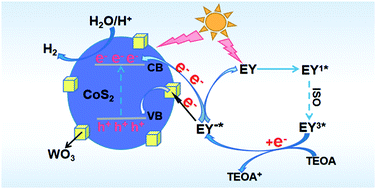Hydrothermal synthesis of WO3/CoS2 n–n heterojunction for Z-scheme photocatalytic H2 evolution
Abstract
One of the most effective methods to improve electron-transfer efficiency and photocatalytic reaction activity is to construct a photocatalyst with a heterojunction interface. Herein, a WO3/CoS2 n–n heterojunction composite catalyst was synthesized, and used in photocatalytic hydrogen evolution, and was optimized by adjusting the pH of the triethanolamine solution, the amount of Eosin Y added, and the content of WO3 in the composite catalyst. After 5 h of photocatalytic reaction, WO3/CoS2 (WCS-2) had a H2 production of 221.15 μmol, which was 80.41 times that of single WO3 and 2.17 times that of CoS2, and had good stability. XRD, SEM, TEM, and XPS characterization results indicated that WO3/CoS2 was successfully prepared. Fluorescence test and electrochemical test results showed that the WO3/CoS2 catalyst had a higher photoelectron transfer efficiency. Finally, it is pointed out that WO3/CoS2 enhanced the photocatalytic activity, which may be due to the electron migration of WO3 and CoS2 following the Z-scheme mechanism. This work presents a new idea for constructing n–n heterojunction to enhance the activity in photocatalytic hydrogen production.



 Please wait while we load your content...
Please wait while we load your content...